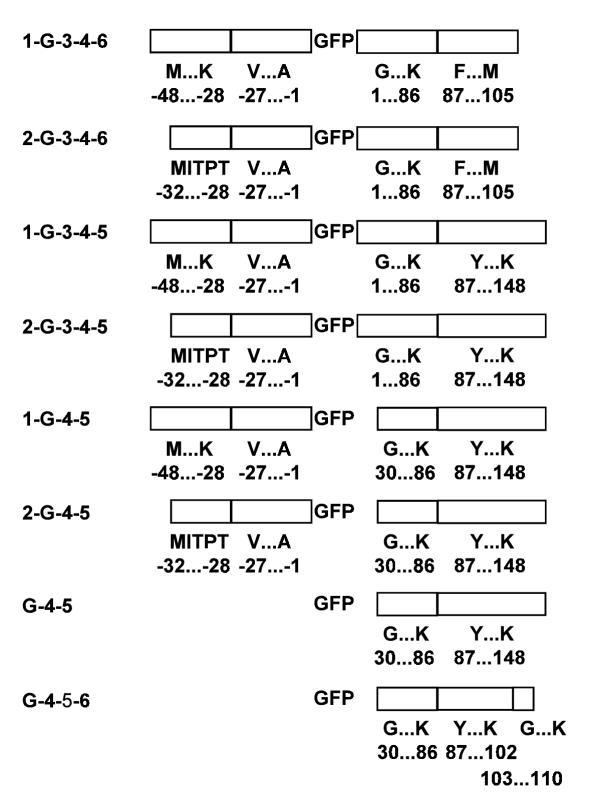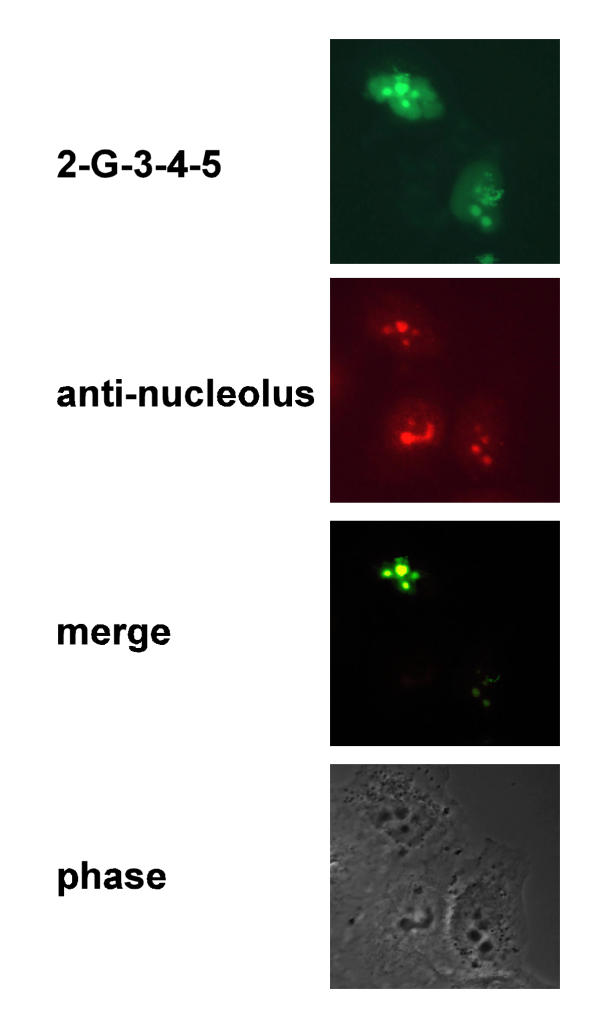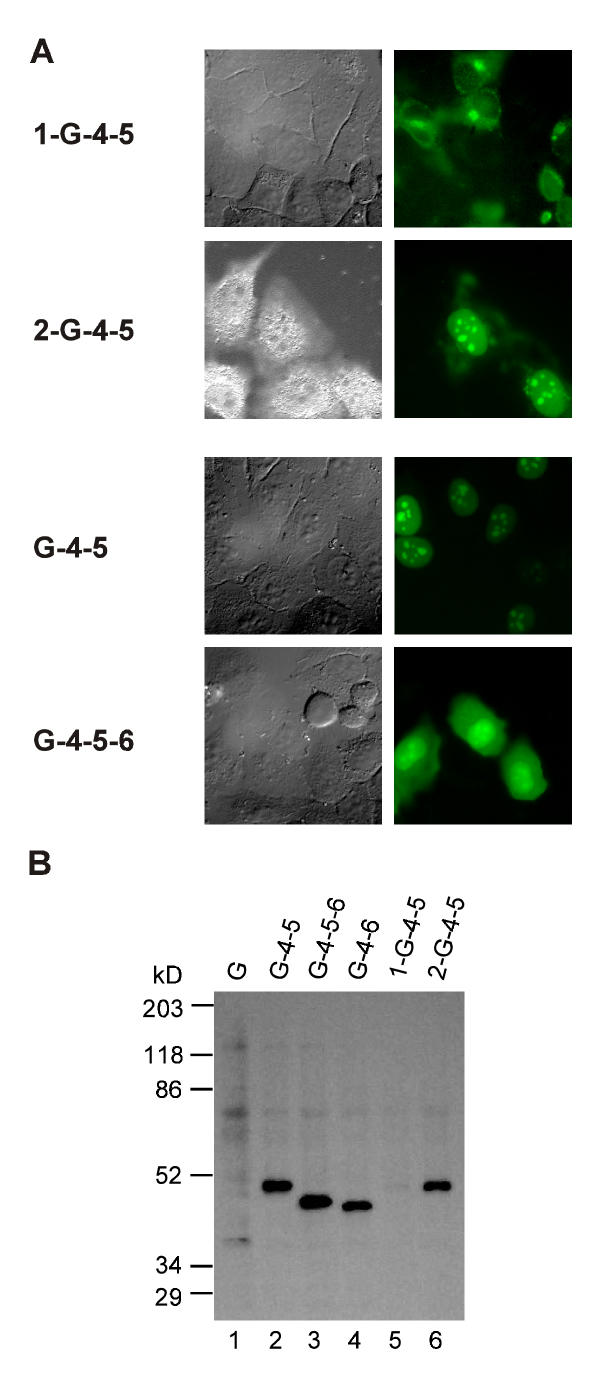Abstract
Background
Alternative exons encode different isoforms of the human insulin-like growth factor-I (IGF-I) precursor without altering mature IGF-I. We hypothesized that the various IGF-I precursors may traffic IGF-I differently. Chimeric IGF-I precursors were made with green fluorescent protein (GFP) cloned between the signal and mature IGF-I domains.
Results
Chimeras containing exons 1 or 2 were located in the cytoplasm, consistent with a secretory pathway, and suggesting that both exons encoded functional signal peptides. Exon 5-containing chimeras localized to the nucleus and strongly to the nucleolus, while chimeras containing exon 6 or the upstream portion of exon 5 did not. Nuclear and nucleolar localization also occurred when the mature IGF-I domain was deleted from the chimeras, or when signal peptides were deleted.
Conclusions
We have identified a nucleolar localization for an isoform of the human IGF-I precursor. The findings are consistent with the presence of a nuclear and nucleolar localization signal situated in the C-terminal part of the exon 5-encoded domain with similarities to signals in several other growth factors.
Background
Most human genes contain introns, which must be excised for correct gene expression. A substantial number of genes are alternatively spliced, generating a great number of protein isoforms [1]. In some cases, experimental evidence has been accrued for distinct function, but most variant isoforms have not been fully characterized. Human IGF-I is a 70 amino acid residue peptide with growth promoting and metabolic actions. Four of the six exons of the human IGF-I gene are alternatively spliced (Fig. 1A). The alternative splices encode different precursor peptides. Exons 1 and 2 are alternative leader exons derived from different transcription start sites, and encode part of the signal peptide [2,3]. The variant N-terminal domains encoded by IGF-I exons 1 or 2 are processed by canine microsomes, suggesting both are functional signal peptides [4]. Parts of exons 3 and 4 encode the mature IGF-I peptide and are constant. Alternative exons 5 and 6 encode different E domains. Part of the E domain encoded by exon 5 contains an amidated growth-promoting peptide [5], but there are little other functional data [6]. Despite the lack of experimental data on functional significance of the isoforms, there is conservation of the genomic architecture of the exons, the splicing patterns producing alternative isoforms [3], and the peptide sequences (Fig. 1B). In this work we investigated the localization of alternative precursors of IGF-I to see if their cellular trafficking differed. We found one isoform that localized to the nucleolus and mapped the domains required for such localization.
Figure 1.
(A) Alternative splicing of the human IGF-I gene. Exons are shown as boxes, introns as lines, transcription start sites as arrows, splicing patterns as sloped lines, and polyadenylation signals as the letter A. The protein coding potential of the exons is indicated underneath. (B) Alignment of predicted alternative E domains. Species are given on the left; non-homologous residues are highlighted in yellow; similarities are underlined.
Results
IGF-I fusion proteins have distinct intracellular localization
The IGF-I chimeras used GFP as a fluorescent reporter (Fig. 2). The two signal peptides, MGKIS (exon 1 and 5' part of exon 3) and MITP (exon 2 and 5' part of exon 3), were fused to the N-terminal of GFP, while the B, C, A and variant E domains of IGF-I were fused to the C-terminal of GFP. This resulted in the expression of four different fusions: 1-G-3-4-6; 2-G-3-4-6; 1-G-3-4-5; and 2-G-3-4-5. When the constructions were expressed in cultured Hela cells, both signal peptides committed the GFP fluorescence to a cytoplasmic structures, consistent with the secretory apparatus (Fig. 3). However, a mixed localization pattern was seen for fusions containing the Eb-encoding exon 5, with a reproducible fluorescence seen in the nucleus and strongly in the nucleolus (Fig. 3). Such localizations were seen in multiple cells, in many independent transfections, with Hela cells from several sources, after shorter times of over-expression, after calcium phosphate and electroporation methods, and there was no correlation between levels of expression and localization (data not shown). Co-localization studies were performed using an anti-nucleolus monoclonal antibody and confirmed the localization as being nucleolar (Fig. 4).
Figure 2.
GFP-IGF-I chimeras. The designations of the chimeras are on the left, while the domain structures of the chimeras are shown only approximately to scale. The first and last amino acid residue of each domain is given underneath, while the numbers are the coordinates relative to the first residue of the mature IGF-I peptide, a glycine.
Figure 3.
Localization of full-length chimeric proteins. The field were imaged by phase contrast (left column) or fluorescence (right column) microscopy. The identity of the chimeras is given on the left.
Figure 4.
Nucleolar localization of chimera containing exon 5. Fluorescence microscopy of Hela cells expressing the chimera and a specific nucleolar antigen detected with an anti-nucleolus antibody. The images were merged electronically and yellow indicates co-localization.
A nucleolar localization signal in the Eb domain
To test the role of IGF-I domains in the nuclear and nucleolar localization, chimeras were constructed that deleted part of exon 3 encoding the B and C domains (2-G-4-5 and 1-G-4-5). The clear nuclear and nucleolar localization remained when the 2-G-4-5 construction was overexpressed (Fig. 5A). However, in the case of the 1-G-4-5 construction, the fluorescence was rapidly exported, and little nuclear or nucleolar localization was seen. We interpret this as an effect of the strength of the secretory signal peptide in competition with the nuclear and nucleolar localization signal(s). To exclude the possibility that the exon 2-encoded signal peptide was directly involved in the nuclear and nucleolar localization, it was deleted from the construction to make G-4-5, which still had a nuclear and nucleolar localization (Fig. 5A). To test the part of the Eb domain with this property, a naturally occurring splice variant, Ec, was used. This splice consists of the 5' portion of exon 5, encoding the N-terminal part of the Eb domain, and then splices to exon 6 [7]. This fusion (G-4-5-6) located throughout the cell, in a diffuse pattern, both in the nucleus and cytoplasm, without the striking nucleolar localization (Figure 5A). These data are consistent with the presence of a nucleolar localization signal at the C-terminal of the Eb domain.
Figure 5.
(A) The mature IGF-I domain is not required for nucleolar localization, while replacing the C-terminal part of the E domain encoded by exon 5 results in loss of specific nucleolar localization. The left panels are phase images except for 2-G-4-5 which was saved as a pseudo-DIC image instead. (B) Western blot of lysates from transfected cells using an anti-GFP antibody. The identity of the transfected chimera is given above the lanes. Positions of the size markers are given on the left.
The E peptides are not cleaved intracellularly
We performed western blotting on lysates from transfected cells (Fig. 5B). The size of the band for G-4-5 (lane 2) was larger than G-4-5-6 (lane 3), while G-4-6 (lane 4) was the smallest. This is compatible with the different sizes of the E domains and shows that the E domains are not cleaved intracellularly. This is despite the presence of previously mapped [8] prohormone processing sites and flanking residues in the chimeric proteins. However, the signal peptides appear to be cleaved, as 1-G-4-5 and 2-G-4-5 gave a band of the same size as G-4-5 (compare lanes 5 and 6 to lane 2). Note the band for 1-G-4-5 was faint on this exposure due to some degradation, but was better seen on overexposed blots (not shown).
Discussion
Using GFP-fusions, we found that the IGF-I exon 5-encoded Eb domain localized chimeric proteins to the nucleus and nucleolus. The localization did not require the signal peptides, mature peptide or the N-terminal part of the Eb peptide. The last four amino acid residues of the Eb domain matches the motif R/K-R/K-X-R/K which is found in several nucleolar localization signals [9]. The presence of the chimeric IGF-I precursors in the nucleus and nucleolus was not an artefact of over-expression since it was seen in cells with varying expression levels and at shorter times after transfection. It is unlikely that this localization was an artefact of tagging because of the consistent pattern seen in different chimeric contexts. Nuclear and nucleolar localization were seen more in the context of the exon 2-encoded, rather than the exon 1-encoded signal peptide, but the signal peptide itself was not required for such localization. This may reflect an indirect action of the signal peptide. Thus, there may be a relative weakness of secretory function for the exon 2-encoded signal peptide compared to that encoded by exon 1. Our data suggest that the signal peptides were efficiently cleaved from the chimeras. The Eb domain was not cleaved from the chimeric precursor IGF-I, and we propose that any biological activity in the nucleolus may be a property of pro-IGF-I. The final location of the chimeras may represent a balance of the competition between secretory and nuclear/nucleolar localization signals.
The nucleolus is a membrane-less dynamic structure organized by transcription and disassembled during mitosis [10]. There are a number of examples of nucleolar localization of growth factors [11]. A well-characterized example is fibroblast growth factor-3, where two nuclear and one nucleolar localization signals act in concert [12] and in competition with secretory signals [13], with an inhibitory action on cell growth [14]. Recently a nucleolar binding protein for fibroblast growth factor-3, NoBP, has been isolated and characterized [15]. A question is whether other nucleolar growth factors also interact with NoBP, or whether they interact through distinct proteins. The nucleolus has multiple functions, including ribosome synthesis, signal recognition particle processing and assembly, and processing of U6 snRNP, snoRNAs, telomerase RNA and tRNAs [16]. The nucleolus is a key site in the regulation of the oncogenic p53-Mdm2-ARF pathway [9]. It is not clear how an isoform of the IGF-I may affect any of these nucleolar functions.
Conclusions
We found that the isoform of the human IGF-I precursor encoded by exon 5 localized to the nucleus and strongly to the nucleolus. Precursors containing exon 6 or the upstream portion of exon 5 did not. Nuclear and nucleolar localization also occurred when the mature IGF-I domain was deleted from the chimeras, or when signal peptides were deleted. The findings are consistent with the presence of a nuclear and nucleolar localization signal situated in the C-terminal part of the exon 5-encoded domain. These findings are similar to the localization of several other growth factors in the nucleolus.
Materials and methods
Construction of chimeric proteins
The chimeric constructions are shown in Fig. 2. Coordinates are given relative to the N-terminal residue (G) of the mature IGF-I peptide. IGF-I exon 1 encodes part of a signal peptide from residues MGK [-48 to -46] to K [-28]. Exon 3 encodes the remainder of the signal peptide from residues VKM [-27 to -25] to A [-1]. This was cloned upstream of the cDNA for GFP. Exon 3 encodes the mature IGF-I peptide starting at residues GPET [1-4] to F [25], exon 4 encodes the mature IGF-I peptide from residue N [26] to A [70] and part of the E domain from residues RSV [71–73] to K [86]. Exon 6 encodes an alternative Ea domain starting at residues FVH [87–89] to M [105]. This IGF-I cDNA sequence is from Genbank X57025 [2]. In other chimeras, exon 2 replaces exon 1 and encodes the residues MITPT [-32 to -28]. The sequence is from Genbank M37484 [3]. Exon 5 encodes an alternative Eb domain starting at residues YDP [87–89] to K [148]. This sequence is from Genbank M11568 [17]. Exon 5–6 encodes the alternative Ec domain, beginning with exon 5-encoded residues YDP [87–89] to K [102], then ending in the exon 6-encoded residues GMTFEERK [103 to 110]. This sequence is from Genbank U40870 [7].
Signal peptides were made by PCR using primers AgeI-IGF-MGKISS (5'-GGCTACCGGTCTTCAGAAGCAATGGGAA) or AgeI-IGF-MITP (5'-GGCTACCGGTATGATTACACCTACAGTGAA) with AgeI-IGF-SPA (5'-GGCTACCGGTCCAGCCGTGGCAGA) and cloned into the AgeI site of pEGFP-C1. This cloning strategy introduces four amino acid residues (PVAT) between the last residue A [-1] of the signal peptide and the first residue of GFP. The mature IGF-I and Ea, or Eb or Ec domains were generated by PCR using primers Eco-GPETLC (5'-GGAATTCCGGACCGGAGACGCTCTGC) and Sac-E6-650A (5'-GCTGAGCCGCGGTTCACTCCTCAGGAGGGTCTT) or Sac-E5-543A (5'-GCTGAGCCGCGGTTTAATCCTCCTGTCCTTCA) or SacII-E6-619A (5'-GCTGAGCCGCGGGTAGTTCTTGTTTCCTGC). The PCR products were cloned into the EcoRI and SacII sites in pEGFP-C1. The chimeras with IGF-I exon 3 deletions were made using the primer EcoRI-MOD4-2244S (5'-GGAATTCCGGGTATGGCTCCAGCAGT) resulting in fusions between GFP and IGF-I from residues GYG [30–32]. EcoRI and SacII cloning sites in pEGFP-C1 were used. All PCR products were made by proof-reading PCR using Pfu Turbo (Stratagene) and all clones were verified by sequencing.
Transfections, cell imaging and western blotting
2 ug of each plasmid was transfected into Hela cells cultured on coverslips in 3 cm wells using 94 ul of Fugene 6 (Boehringer). After 12–24 hours of expression, cells were incubated at room temperature for one hour and fixed in 2% w/v paraformaldehyde. Cells subjected to immunofluorescence were washed in PBS, permeabilized with 0.2% v/v Triton X100 in 1% v/v normal goat serum, before incubation with an anti-human nucleolus monoclonal antibody (Calbiochem). After washes in 1% normal goat serum, cells were incubated with a Texas-red-labeled goat anti-mouse antibody (Jackson Labs). All coverslips were mounted on glass slides and imaged with a fluorescent microscope (Leica DMR) and a charge-coupled device camera (Leica DC200). For western blotting, cells from 3 cm wells were harvested in Laemmli buffer containing 6 M urea. 10 ug of total cellular protein was loaded onto a 12% SDS-PAGE, then semi-dry blotted onto Hybond C+ (Amersham) before blocking and incubation with monoclonal anti-GFP antibodies (Boehringer).
Authors' contributions
DSWT and AC made some of the constructions and performed transfections and immunofluorescence. SLC designed the experiments and constructions, made some of the constructions and performed some of the experiments. All authors read and approved the final manuscript.
Acknowledgments
Acknowledgements
We are grateful to C. Camacho-Hubner for helpful discussions and M. D. Turner for comments on the manuscript. The work was partly supported by the Wellcome Trust (045401).
Contributor Information
Daniel SW Tan, Email: dswtan@hotmail.com.
Alexandra Cook, Email: a.k.cook@mds.qmw.ac.uk.
Shern L Chew, Email: s.l.chew@mds.qmw.ac.uk.
References
- Graveley BR. Alternative splicing: increasing diversity in the proteomic world. Trends Genet. 2001;17:100–107. doi: 10.1016/S0168-9525(00)02176-4. [DOI] [PubMed] [Google Scholar]
- Jansen M, van Schaik FMA, Ricker AT, Bullock B, Woods DE, Gabbay KH, et al. Sequence of cDNA encoding human insulin-like growth factor I precursor. Nature. 1983;306:609–611. doi: 10.1038/306609a0. [DOI] [PubMed] [Google Scholar]
- Tobin G, Yee D, Brunner N, Rotwein P. A novel human insulin-like growth factor I messenger RNA is expressed in normal and tumor cells. Mol Endocrinol. 1990;4:1914–1920. doi: 10.1210/mend-4-12-1914. [DOI] [PubMed] [Google Scholar]
- Yang H, Adamo ML, Koval AP, McGuinness MC, Ben-Hur H, Yang Y, et al. Alternative leader sequences in insulin-like growth factor I mRNAs modulate translational efficiency and encode multiple signal peptides. Mol Endocrinol. 1995;9:1380–1395. doi: 10.1210/mend.9.10.8544846. [DOI] [PubMed] [Google Scholar]
- Siegfried JM, Kasprzyk PG, Treston AM, Mulshine JL, Quinn KA, Cuttitta F. A mitogenic peptide amide encoded within the E peptide domain of the insulin-like growth factor IB prohormone. Proc Natl Acad Sci USA. 1992;89:8107–8111. doi: 10.1073/pnas.89.17.8107. [DOI] [PMC free article] [PubMed] [Google Scholar]
- Lund PK, Hepler JE, Hoyt EC, Simmons JG. Physiological relevance of IGF-I mRNA heterogeneity. In: Spencer EM, editor. In Modern concepts of insulin-like growth factors. New York: Elsevier Science Publishing Co; 1991. pp. 111–120. [Google Scholar]
- Chew SL, Lavender P, Clark AJL, Ross RJM. An alternatively spliced human IGF-I transcript (IGF-IEc) with hepatic tissue expression that diverts away from the mitogenic IBE1 peptide. Endocrinology. 1995;136:1939–1944. doi: 10.1210/endo.136.5.7720641. [DOI] [PubMed] [Google Scholar]
- Duguay SJ, Lai-Zhang J, Steiner DF. Mutational analysis of the insulin-like growth factor I prohormone processing site. J Biol Chem. 1995;270:17566–17574. doi: 10.1074/jbc.270.29.17566. [DOI] [PubMed] [Google Scholar]
- Weber JD, Kuo ML, Bothner B, DiGiammarino EL, Kriwacki RW, Roussel MF, et al. Cooperative signals governing ARF-mdm2 interaction and nucleolar localization of the complex. Mol Cell Biol. 2000;20:2517–2528. doi: 10.1128/MCB.20.7.2517-2528.2000. [DOI] [PMC free article] [PubMed] [Google Scholar]
- Dundr M, Misteli T, Olson MO. The dynamics of postmitotic reassembly of the nucleolus. J Cell Biol. 2000;150:433–446. doi: 10.1083/jcb.150.3.433. [DOI] [PMC free article] [PubMed] [Google Scholar]
- Pederson T. Growth factors in the nucleolus? J Cell Biol. 1998;143:279–281. doi: 10.1083/jcb.143.2.279. [DOI] [PMC free article] [PubMed] [Google Scholar]
- Antoine M, Reimers K, Dickson C, Kiefer P. Fibroblast growth factor 3, a protein with dual subcellular localization, is targeted to the nucleus and nucleolus by the concerted action of two nuclear localization signals and a nucleolar retention signal. J Biol Chem. 1997;272:29475–29481. doi: 10.1074/jbc.272.47.29475. [DOI] [PubMed] [Google Scholar]
- Kiefer P, Acland P, Pappin D, Peters G, Dickson C. Competition between nuclear localization and secretory signals determines the subcellular fate of a single CUG-initiated form of FGF3. EMBO Journal. 1994;13:4126–4136. doi: 10.1002/j.1460-2075.1994.tb06730.x. [DOI] [PMC free article] [PubMed] [Google Scholar]
- Kiefer P, Dickson C. Nucleolar association of fibroblast growth factor 3 via specific sequence motifs has inhibitory effects on cell growth. Mol Cell Biol. 1995;15:4364–4374. doi: 10.1128/mcb.15.8.4364. [DOI] [PMC free article] [PubMed] [Google Scholar]
- Reimers K, Antoine M, Zapatka M, Blecken V, Dickson C, Kiefer P. NoBP, a nuclear fibroblast growth factor 3 binding protein, is cell cycle regulated and promotes cell growth. Mol Cell Biol. 2001;21:4996–5007. doi: 10.1128/MCB.21.15.4996-5007.2001. [DOI] [PMC free article] [PubMed] [Google Scholar]
- Pederson T. The plurifunctional nucleolus. Nucleic Acids Res. 1998;26:3871–3876. doi: 10.1093/nar/26.17.3871. [DOI] [PMC free article] [PubMed] [Google Scholar]
- Rotwein P. Two insulin-like growth factor I messenger RNAs are expressed in human liver. Proc Natl Acad Sci USA. 1986;83:77–81. doi: 10.1073/pnas.83.1.77. [DOI] [PMC free article] [PubMed] [Google Scholar]







